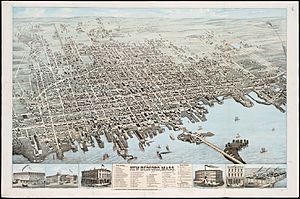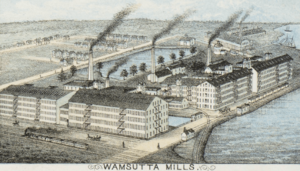Abolitionism in New Bedford, Massachusetts facts for kids
Abolitionism in New Bedford, Massachusetts, was a strong movement against slavery. It started in the late 1820s with Quakers speaking out. Then, in 1833, African Americans formed their own group called the New Bedford Union Society. A year later, a mixed group of people, both Black and white, created the New Bedford Anti-Slavery Society.
During this time, New Bedford, Massachusetts, became known as a safe place for people escaping slavery. It was on the East Coast of the United States and was becoming the "whaling capital of the world." Ships often returned to port with crews from many different backgrounds. This made it easy for people escaping slavery to blend in with the sailors. The whaling and shipping industries were also open to people of color.
Even though only about 15% of the town supported abolition, New Bedford offered many chances for African Americans. They could own homes, get an education, and find steady jobs. They also helped others escape slavery using the Underground Railroad. By the end of 1853, New Bedford had the highest percentage of African Americans in any city in the Northeastern United States.
Abolitionists invited speakers, including former slaves, to share their stories about the terrible conditions of slavery. Frederick Douglass, a former slave who lived in New Bedford, became a powerful speaker. Stories written by former slaves in New Bedford also showed what life was like under slavery. Sometimes, abolitionists even paid to free people who were about to be forced back into slavery. They also had a store that sold goods not made by enslaved people, as part of the free-produce movement.
New Bedford had its challenges too. Its cotton mills used cotton from the Southern United States, which was picked by enslaved people. Some people in town were also unkind to former slaves because of racial prejudice.
Contents
Why New Bedford Was Important for Freedom Seekers
New Bedford was home to important Quakers, abolitionists, and free African Americans. Families like the Arnolds, Grinnells, Rotchs, Rodmans, and Robesons were key figures. Abolition Row, including Sixth and Seventh Streets, was a neighborhood where these founding families lived. These areas show how abolitionists and whaling employers hired a diverse group of workers.
In the 1800s, New Bedford was one of the richest cities in the country. This was because of the profitable whaling industry. Whale oil was used to light lamps around the world, earning New Bedford the nickname "the city that lit the world."
However, only about 15% of the community were abolitionists. They knew their anti-slavery efforts could be dangerous. There were also different ideas among abolitionists about things like intermarriage and full equality.
Even though New Bedford was often welcoming, some people still showed racial prejudice. For example, white workers on a whaling ship once threatened to leave if a skilled Black man, Frederick Douglass, was hired.
This uncivil, inhuman and selfish treatment was not so shocking and scandalous in my eyes at the time as it now appears to me. Slavery had inured me to hardships that made ordinary trouble sit lightly upon me. Could I have worked at my trade I could have earned two dollars a day, but as a common laborer I received but one dollar.
—Frederick Douglass, Life and Times of Frederick Douglass, Written by Himself, 1892.
Before the American Civil War, slavery was illegal in Massachusetts. But the country's economy still relied on it. For example, northern cotton mills used cotton from the South. Despite this, New Bedford was a unique and diverse place. After the Fugitive Slave Act of 1850 was passed, most people in New Bedford strongly opposed it.
How People Fought Against Slavery
Anti-slavery groups in New Bedford often started with both Black and white members. But over time, they sometimes became separate. The New Bedford Anti-Slavery Society was formed in 1834 as a mixed group. Its first president, Rev. John Choules, was a white English immigrant. There was also the Bristol County Anti-Slavery Society. Separate groups were made for young men and for women. The Quaker meetinghouse was a place where anti-slavery speeches were given and was likely a safe house for people escaping slavery.
New Bedford was a port town, with ships arriving from all over the world. This brought people of many different cultures and languages. It was easy for someone who escaped slavery on a ship to blend in with the crowd. Many people escaping slavery arrived in New Bedford from places like Norfolk, Virginia. New Bedford became known for safely hiding them, even after the Fugitive Slave Act of 1850. One slave owner, Major Hodsdon, said that he and others tried everything to find the "negro thieves" (meaning the people who helped slaves escape). But they were never successful. Some ship owners who helped save slaves faced boycotts. Even whale oil from New Bedford was boycotted. Newspapers in the South spread false stories, saying people from New Bedford were crazy. Despite the chance to flee to Canada, Thomas Bayne, a former slave, chose to stay in New Bedford, calling it the "Fugitive's Gibraltar."
From my earliest recollection, I date the entertainment of a deep conviction that slavery would not always be able to hold me within its foul embrace.
People in New Bedford paid famous abolitionist speakers to come and talk. William Lloyd Garrison, a strong abolitionist, spoke at a Bristol County Anti-Slavery Society meeting in 1841. Frederick Douglass also spoke that day about his life as a slave. This led to him becoming a lecturer for the Massachusetts Anti-Slavery Society.

Women in New Bedford set goals for raising money for anti-slavery efforts. After the Civil War, women raised money to buy books for schools in the South. By 1838, African Americans R C and E R Johnson opened a free-produce store. They sold sugar, molasses, coffee, rice, and other goods that were not made by enslaved people.
People who escaped slavery were often chased by their former masters. But New Bedford business owners would not let them be returned. This was partly because it would affect their workforce. Some wealthy employers even helped their Black employees buy homes by lending them money.
The African-American Community in New Bedford

New Bedford became one of the best places for people escaping slavery between 1790 and the American Civil War. Henry Box Brown and Frederick Douglass were among about 700 former slaves who found safety there. Their experiences were written down in slave narratives and shared by abolitionists.
New Bedford was a small town of 3,000 people until the whaling industry grew. It then became known as the whaling capital of the world. Between 1830 and 1840, the town's population grew by 60% to about 12,000 people. The number of Black people was 767, which was a higher percentage than any other community in Massachusetts.
Working on ships, especially whaling ships, was good for free Black people and those who had escaped slavery. The shipping industry welcomed workers of all races. The whaling industry had a high turnover of crew members, and African Americans helped fill these jobs. By 1848, one in six crew members on whaling ships were Black. They shared small living spaces on the ships.
At first, Black people often lived in the homes of their white employers. By 1830, only 12% of African Americans lived with employers. The rest could live more independently. By 1850, 9.3% of African Americans in New Bedford worked in skilled trades. This was higher than in other northern cities. By the end of 1853, New Bedford had the highest percentage of African Americans in the Northeast.
African Americans were active in social, anti-slavery, and political groups. Schools were integrated, meaning Black and white students attended together. However, churches were usually separate. For example, by the mid-1800s, Paul Cuffe was one of the only known Black people admitted to a Quaker church in southeastern Massachusetts. Frederick Douglass felt uncomfortable in white churches and joined the African-Methodist-Episcopal Church.
While African Americans had chances to succeed in New Bedford, it was still hard for many. They often lived in less desirable parts of town and had low-paying jobs. These jobs included washing clothes, driving carriages, or being handymen. However, some successful Black business owners lived in nicer areas.
Important People in New Bedford's Anti-Slavery Movement

Frederick Douglass arrived in New Bedford in 1838 after escaping slavery. He found that his ability to earn money was limited because of his skin color. Even though he had special skills, he could only get common labor jobs. He dug, cleaned, chopped wood, and loaded ships for half the pay of white workers. Later, he got a steady job at a whale oil refinery, working alongside white men. He became a very moving speaker, telling audiences about the horrors of slavery.
Nathan and Polly Johnson were African-American business owners. They regularly gave shelter to people seeking freedom from slavery at their home. Douglass and his family stayed with the Johnsons from 1838 to 1839. It was their first home after escaping slavery. Nathan Johnson was elected president at the 1847 National Convention of Colored People. He was also a delegate to the annual convention of free people of color from 1832 to 1835.
African-American Abolitionists
Quaker and Other White Abolitionists
Historical Sites and Events to Explore
In New Bedford, you can learn more about its anti-slavery history. There are regular Underground Railroad tours. The Black History Trail has 24 stops, including the Paul Cuffe Park, Sgt. William Carney Memorial Homestead, and Lewis Temple Statue. Every year, there's a read-a-thon of the Narrative of the Life of Frederick Douglass, an American Slave. People take turns reading the story aloud continuously.
See Also




